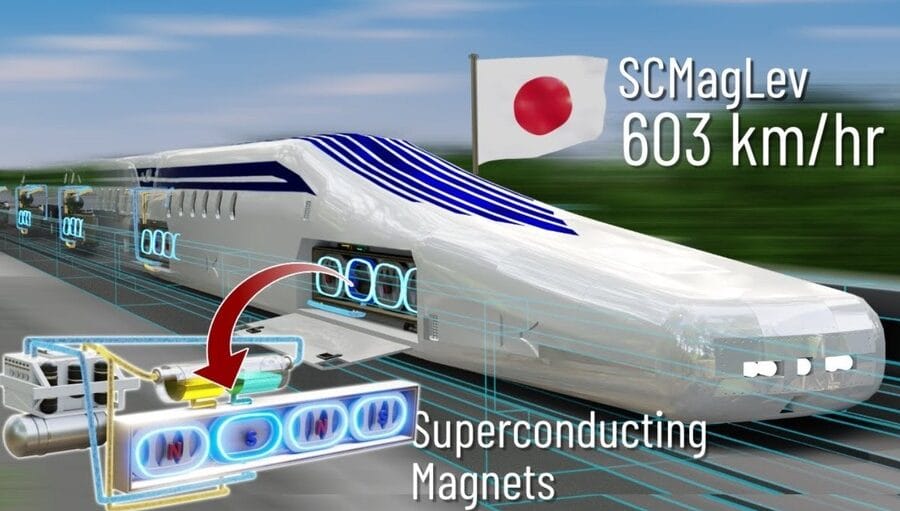Introduction
Maglev ! Imagine a train that doesn’t touch the tracks, gliding smoothly and silently at breathtaking speeds. This futuristic mode of transport is no longer a dream but a reality, thanks to Magnetic Levitation, or Maglev technology. But how do these trains “float” in the air, and why are they considered revolutionary in the world of transportation?
The 21st centur has seen unparalleled advancements in transportation technologies, reshaping how people and goods move across the globe. Among these innovations, magnetic trains, or Maglev (Magnetic Levitation), represent a breakthrough in high-speed, efficient, and environmentally friendly travel. By eliminating traditional components like wheels and rails, Maglev technology has introduced a new era of transportation that prioritizes speed, comfort, and sustainability. This article delves deeply into Maglev trains, exploring their technology, history, benefits, challenges, and future potential.
What is a
Magnetic Train (Maglev)?
A magnetic train, or Maglev, uses magnetic forces for levitation, guidance, and propulsion, enabling it to “float” above a specially designed track. This eliminates the friction between train and rail, a significant limitation in conventional trains. Maglev trains utilize powerful electromagnets and superconducting materials to achieve their unique functionality.
- Levitation:
- Guidance:
- Propulsion:
- Linear motors embedded in the guideway create alternating magnetic fields to push and pull the train forward.
Maglev technology is not just an evolution of traditional rail systems; it is a reimagining of the concept of train travel. Magnetic trains are called Maglev because the term is short for Magnetic Levitation
The Technology Behind
Maglev
Maglev trains operate using the principles of magnetism and electromagnetic forces. Here are the main technologies behind them:
- Types of Maglev Systems:
- Electromagnetic Suspension (EMS):
- Electrodynamic Suspension (EDS):
- Linear Motors for Propulsion:
- Superconducting Materials:
The History of Magnetic Trains
The concept of magnetic levitation is not a recent innovation. Its history spans over a century:
- Early Concepts:
- Development Phase:
- In the 1960s and 1970s, Japan and Germany began experimenting with Maglev prototypes.
- Japan’s Yamanashi Maglev Test Line (more) became a testing ground for the high-speed SCMaglev system in the 1990s.
- First Operational Systems:
- The world’s first commercial Maglev system was the Birmingham Airport Maglev in the UK, operational in 1984. Although short-lived, it marked the beginning of Maglev transportation.

- In 2003, China introduced Shanghai Maglev(more), a high-speed commercial system connecting Pudong Airport to downtown Shanghai.

- The world’s first commercial Maglev system was the Birmingham Airport Maglev in the UK, operational in 1984. Although short-lived, it marked the beginning of Maglev transportation.
- Modern Advancements:
Today, countries like Japan, China, and South Korea lead the way in Maglev technology, with ambitious plans for regional and international networks.
Companies and Countries
Leading Maglev Innovation
Several nations and corporations have pioneered Maglev development:
- Japan:
- China:
- Germany:
- South Korea:
- South Korea operates the Incheon Airport Maglev, a low-speed system providing efficient airport connectivity.
- United States:
- Maglev projects like the Washington D.C. to Baltimore corridor aim to bring high-speed rail to North America, though funding challenges remain.
Applications Beyond
Passenger Transport
Maglev trains are not limited to passenger travel. Potential applications include:
- Freight Transport:
High-speed Maglev systems could revolutionize logistics, reducing delivery times for time-sensitive goods like perishable items. - Urban Transit:
Maglev technology can be integrated into city metro systems, offering faster and more efficient connectivity than conventional subway networks. - Hyperloop Technology:
Inspired by Maglev, Hyperloop systems use magnetic levitation in vacuum tubes to achieve even higher speeds, potentially exceeding 1000 km/h.
Advantages of Maglev Trains
Maglev trains offer numerous benefits over conventional rail systems:
- Exceptional Speed:
Maglev systems can reach speeds over 600 km/h, significantly reducing travel time between cities. - Smooth and Comfortable Travel:
The absence of physical contact eliminates vibrations and wheel noise, providing a smoother ride. - Eco-Friendly Operation:
Maglev systems produce lower emissions, especially when powered by renewable energy sources. - High Safety Standards:
Guided tracks and advanced control systems minimize risks like derailments. - Durability:
With no moving parts, Maglev systems experience less wear and tear, reducing maintenance requirements.
Disadvantages of Maglev Trains
Despite their benefits, Maglev trains face significant challenges:
- High Initial Costs:
Building Maglev tracks and infrastructure is expensive, often limiting widespread adoption. - Energy Demands:
While efficient during operation, the energy required for propulsion and levitation is substantial. - Limited Compatibility:
Maglev tracks are unique and cannot integrate with existing rail networks. - Complex Maintenance:
Maintaining superconducting magnets and control systems requires specialized expertise.
Maglev vs. Other Train Types: A Comparative Table
| Feature | Maglev | High-Speed Rail | Conventional Rail |
|---|---|---|---|
| Speed | 300–600+ km/h | 200–350 km/h | 50–160 km/h |
| Friction | None | Minimal | High |
| Noise Pollution | Low | Moderate | High |
| Energy Efficiency | High | Medium | Low |
| Infrastructure Cost | Very High | High | Moderate |
The Growing Need for
Maglev Trains
The demand for faster, cleaner, and more efficient transportation continues to grow. Maglev technology addresses several critical challenges:
- Urban Congestion:
High-capacity Maglev systems can reduce traffic congestion in densely populated areas. - Environmental Concerns:
Maglev systems can replace carbon-intensive modes of transport, reducing greenhouse gas emissions. - Economic Growth:
By connecting cities faster, Maglev can spur economic development and regional integration.
The Future of Maglev Technology
Maglev technology is still evolving, with exciting advancements on the horizon:
- Renewable Energy Integration:
Solar and wind power could make Maglev systems more sustainable. - Global Networks:
Ambitious plans for transcontinental Maglev networks could transform international travel. - Hyperloop Synergy:
Combining Maglev with Hyperloop technology could unlock unprecedented speeds and efficiencies.
Conclusion
Maglev trains are a remarkable achievement in transportation, offering unparalleled speed, efficiency, and sustainability. While challenges like cost and infrastructure remain, ongoing innovation promises to make Maglev more accessible and impactful. As cities and countries seek greener, faster, and smarter solutions, Maglev technology stands poised to lead the charge, redefining how the world moves in the decades to come.
(Click notification ![]() for more updates)
for more updates)













